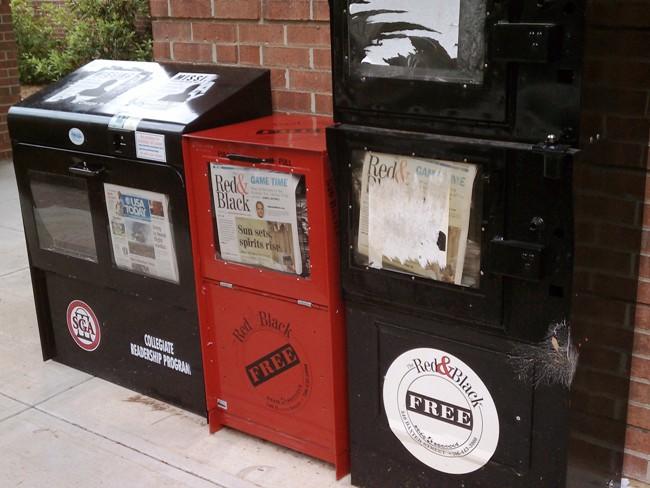
Section Branding
Header Content
UGA's Red & Black Now 'Digital First'
Primary Content

On a recent Wednesday evening in the Red & Black newsroom, the atmosphere is more like things used to be than they are now.
Wednesday is when the student staff finishes the now-weekly edition of the printed newspaper that hits racks Thursday. The other days are devoted to a new digital-first model, where most daily news goes online and the weekly print edition is full of stories that deserve more space and can stay on newsstands for a week.
The student-run Red & Black at the University of Georgia is the first high-profile college paper in the country to go “digital-first,” and it’s a big shift for a hundred-year-old newspaper that had been physically put in newsstands every day.
“We’re doing this for our students and for the university community,” said Red & Black Editor in Chief Rachel Bowers, a 22-year-old senior majoring in journalism. “This is what we feel like happening in the industry and we should be on the cutting edge of that since we are one of the top college newspapers, news organizations in the country.”
Of course, the student journalists haven’t completely abandoned the printing press. There’s the weekly paper, and they’re also now producing a monthly glossy magazine.
Editorial Adviser Ed Morales said students still want to see their name on the printed page, so they were initially a little resistant to the idea of “digital-first.”
“They didn’t necessarily think it counted if it wasn’t in print,” Morales said. “And I was like, you know, the newspaper is gone in like two days. It’s in the bin. Your story online is going to be there forever.”
Plus, Morales can tell the Red & Black’s staff how many people have read each story and visited the Web site each day.
“When you see that 50,000, 60,000 people are reading our website everyday, that’s really, really rewarding,” Bowers said. “So I think a lot of the writers have come around to the idea that this makes sense.”
Editors and writers also are learning how to use video and audio to tell stories, skills they will need if they want a job in journalism.
The Red & Black is a nonprofit company with a board of directors and no financing from UGA. But it has not been immune to the downturn in the newspaper industry.
“We’ve seen our revenues decline,” publisher Harry Montevideo said. “[At] our peak, we were at about $1.5 million; last year, we did about $1.2 million. So actually a slower decline than the industry has felt, but still significant enough.”
Given falling revenues, a shift to “digital-first” was a risk with a big unknown: would advertisers go along? That turned out not to be much of an issue.
“[Advertisers] said they were interested in reaching the market, and if they’d spent $500 or $1,000 before each week reaching that market, they would probably spend that same amount whether we published weekly or daily,” Montevideo said.
It’s still too early to see the impact on the paper’s revenue, but college papers around the country are watching the Red & Black’s numbers.
“People are genuinely interested to see if it does work,” said Logan Aimone, executive director of Associated Collegiate Press.
“Kudos to the folks at the Red & Black for being willing to say, we’re all in, we’re doing this, and everyone else is sort of holding their breath and, I think, crossing their fingers and hoping it does work,” Aimone said.
Professional journalists might be watching too, but for slightly different reasons.
“To a certain extent, we’re talking about the changing media habits and preferences of younger people, sort of by definition,” said Rick Edmonds, a media business analyst at the Poynter Institute for Media Studies.
Advertisers are interested to follow those changing consumer habits. Edmonds said the industry will be watching to see if advertisers go digital-first, too.
Tags: University of Georgia, UGA, Red & Black, college journalism, journalism, student newspaper
